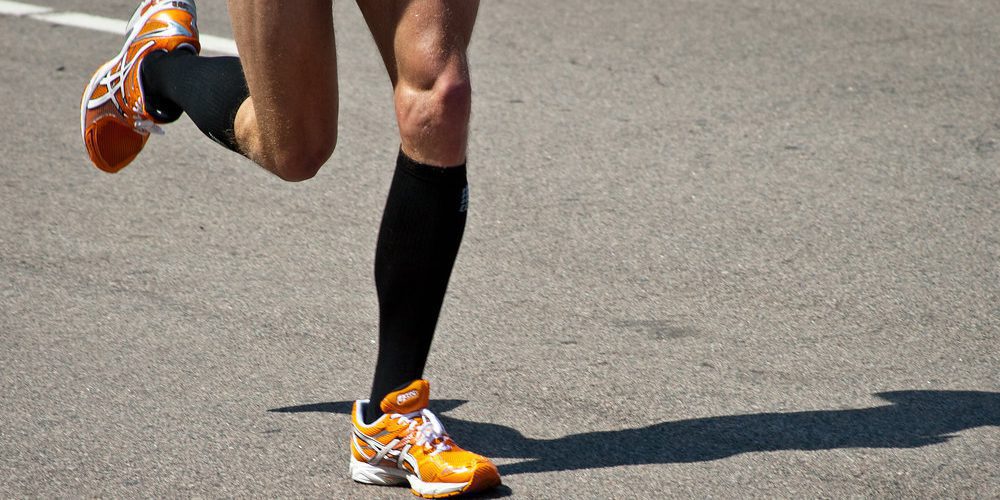Compression socks are a popular choice for runners. They provide many benefits, which is why runners swear by them. In this article, we will discuss the reasons why compression socks are so beneficial for runners. We will also cover the different types of compression socks available and how to choose the right pair for you.
What are compression socks and why do runners wear them
Compression socks are a type of closely fitted sock that applies pressure to your legs and feet. The pressure is believed to help with blood flow and reduce inflammation.
Compression socks are often recommended for runners because they can help prevent pain and injuries. For example, research suggests that compression socks can help to prevent shin splints, a common running injury.
Additionally, compression socks can help to relieve the pain and swelling associated with Achilles tendinitis, another common injury among runners.
Compression socks can also aid recovery after a long run by helping to reduce muscle soreness.

Most runners wearing compression socks mention improved results, faster recovery times and less injuries. And while this is not medically proven, the results and statistics don’t lie. But how do compression socks work in detail?
There are several different ways that compression socks work. First, they help to increase the amount of oxygen-rich blood that flows to the muscles by applying pressure to the veins and arteries. This helps the muscles to work more efficiently and reduces fatigue. Additionally, compression socks help to reduce inflammation by applying pressure to the surrounding tissues. This helps to reduce swelling and pain, both of which can lead to improved performance and faster recovery times. Finally, compression socks can also help to prevent injuries by providing support to the muscles and joints. All of these factors make compression socks an essential piece of equipment for any runner.
The benefits of compression socks for runners
Compression socks are not just for grandpa anymore. These days, an increasing number of runners are lacing up compression socks in an effort to improve their performance. And it’s not just athletes who are reaping the benefits of compression socks; more and more people are using them to relieve pain, reduce swelling, and improve circulation.
There is scientific evidence to support the claims that compression socks can improve circulation and reduce swelling. In one study, participants who wore compression socks had less swelling after running than those who did not wear them. In another study, compression socks were found to improve blood flow in the legs during exercise. This is likely due to the fact that compression socks apply pressure to the veins and arteries, helping to keep blood from pooling in the lower legs. Additionally, the increased blood flow means that more oxygen-rich blood is being circulated through the body, which can lead to improved athletic performance.
Whether you are a casual jogger or a competitive runner, consider giving compression socks a try. You may be surprised at how much they can help you feel better both during and after your run.
How to choose the right pair of compression socks
Compression socks are a must-have for any runner, whether you’re just starting out or you’ve been running for years. But with so many different types and brands on the market, it can be tough to know which pair is right for you. Here are a few things to keep in mind when choosing compression socks:
First, consider the fabric. Most compression socks are made from either nylon or spandex, but some also contain polyester or other synthetic materials. If you have sensitive skin, look for a pair made from breathable material that won’t irritate your skin.
Next, think about the fit. Compression socks should be snug but not too tight. They should also reach up to your mid-calf or higher. If they’re too loose, they won’t provide the level of support you need; if they’re too tight, they could cut off circulation.
Finally, take into account the style. Compression socks come in a variety of styles, including ankle-length, calf-length, and knee-length. Choose the style that best suits your needs and preferences.
Once you’ve considered all of these factors, you’ll be able to narrow down your options and find
The different types of compression socks available
Compression socks have become increasingly popular in recent years, as both runners and non-runners alike have discovered the benefits of this versatile garment. Whether you’re looking to improve your circulation, reduce muscle soreness, or prevent injuries, there’s a pair of compression socks that’s right for you.
One of the most popular types of compression socks is the ankle-length sock. This style provides support for the entire lower leg, from the ankle all the way up to the knee. Ankle-length socks are ideal for runners or other athletes who are seeking maximum support and stability.
If you prefer a less constrictive feel, calf-length compression socks may be a better option. These socks provide support for the calf muscles, but they don’t extend all the way up to the knee. Calf-length socks are a good choice for everyday wear, as they’re comfortable and won’t interfere with your clothing.
Finally, knee-length compression socks are designed to provide support for the entire leg, from the knee all the way down to the foot. Knee-length socks are often used by people who suffer from chronic pain or swelling in their legs. No matter which style you choose, compression socks can help improve your circulation and reduce muscle soreness.
The next thing that differentiates the various types of compression socks is their compression level. The unit of measurement is mmHg which stands for millimeters of mercury, the standard scientific scale for pressure. Compression socks usually range from 15-20 mmHG up to 40 mmHg. The higher the number, the greater the compression.
15-20 mmHG: This is a mild level of compression that is often used for everyday wear and minor swelling.
20-30 mmHG: This is a moderate level of compression that is often used for more serious conditions such as chronic venous insufficiency or edema.
30-40 mmHG: This is a high level of compression that is typically only used for very severe conditions such as lymphedema or deep vein thrombosis. It is important to note that this level of compression should only be used under the supervision of a doctor.

Compression socks are available in a variety of colors, patterns, and styles. While some people prefer to choose socks that match their workout gear, others prefer to make a statement with their socks. No matter what your personal style is, you’re sure to find a pair of compression socks that you love.
How to care for your compression socks
Compression socks can also be quite delicate, so it is important to take care when washing and storing them. Here are some tips on how to care for your compression socks:
Wash them by hand in cool water using a mild detergent. Avoid fabric softeners, as they can break down the fabric. Gently squeeze out excess water, but do not wring or twist the socks. Allow them to air dry. Store them in a cool, dry place out of direct sunlight. Do not fold or crease the socks, as this can damage the fabric.
By following these simple tips, you can help extend the life of your compression socks and ensure that they continue to provide support and improve blood circulation during your workouts.
Alternatives to compression socks
Compression socks have long been a staple of runner’s gear, but they’re not the only option when it comes to keeping your legs feeling fresh.
Alternative legwear options such as compression tights, calf sleeves, and even kinesiology tape can offer similar benefits to compression socks, without the need for special sizing or tightness levels.
Compression tights, for example, provide full coverage from the waist down, making them ideal for those who want to avoid chafing or other issues in hot weather.
Calf sleeves, on the other hand, offer targeted support to the muscles and tendons in the lower leg, helping to reduce inflammation and improve blood flow.
And kinesiology tape can be used to help support weak or injured muscles, as well as provide relief from pain and swelling.
So whether you’re looking for full-leg coverage or targeted support, there’s an alternative legwear option that can help you run your best.
Takeaways
Compression socks are a runner’s best friend. Not only do they help improve blood circulation and reduce muscle soreness, but they’re also great for preventing chafing and other issues in hot weather. There are a variety of colors, patterns, and styles to choose from, so you’re sure to find a pair that you love. And by following a few simple care tips, you can help extend the life of your compression socks.
If you’re looking for an alternative to compression socks, there are a number of options available, including compression tights, calf sleeves, and kinesiology tape. So whether you’re looking for full-leg coverage or targeted support, there’s an option out there that can help you run your best.
Do you have any questions about compression socks? Leave a comment below and let us know. And be sure to check out our shop and blog for more information on the essentials you need to hit the road.
Happy running!





















